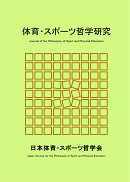
- Issue 2 Pages 49-
- Issue 1 Pages 1-
- |<
- <
- 1
- >
- >|
-
Kyu SASAKI, Kentaro TAI2021 Volume 43 Issue 1 Pages 1-14
Published: 2021
Released on J-STAGE: October 10, 2021
JOURNAL FREE ACCESSIt often has been pointed out that the concept of sports as lifelong learning is an issue. The difficulty is whether theoretical models of lifelong development can serve as a basis for the concept of lifelong sports because one’s performance reduces due to the reduction of physical strength from aging. Thus, it is doubtful whether the concept of lifelong sports can be established.
This paper aims to consider this difficulty and find solutions by revealing misunderstandings and prejudices that underlie arguments related to the subject. Lifelong sports depends on lifelong learning, therefore, we focus on examining the possibility of establishing this concept by outlining what “development” and “improvement” entails. Next, we question some of the components of sports activities and utilize case studies to define a range of education for lifelong learning through sports activities.
The main findings indicated that according to lifelong learning theory, learning rightfully includes the pursuit of improvements in physical strength and peak performance, which is required in participating in sports. Moreover, it is possible to continue to learn through sports activities even when one’s physical strengths are declining.
However, the possibility of learning through sports activities is a research topic that should continue to be pursued. Because not all sports values as cultivating properties have yet been elucidated. Any progress towards identifying and describing these values will firmly establish the concept of sports as lifelong learning.
Thus, this paper is the first step towards solving the abovementioned difficulty of sports as lifelong learning.
View full abstractDownload PDF (1114K)
-
Mitsuharu OMINE2021 Volume 43 Issue 1 Pages 15-22
Published: 2021
Released on J-STAGE: October 10, 2021
JOURNAL FREE ACCESSIn this study, I reviewed the pros and cons of playoffs in the field of sport philosophy, and derived the points in questioning the pros and cons. The purpose of this study was to gain a new perspective on the institutional characteristics of professional baseball, including the climax series, from the points discussed.
In the previous research, athletic excellence was an issue, so in this study I considered institutional characteristics of professional baseball from the viewpoint of excellence of baseball. As a result, the following points became clear.
1. Like the pennant race, the climax series competes for the overall scoring ability of the entire team, including striking ability, running ability, defensive ability, and situation judgment ability. Therefore, the climax series is not at the expense of measuring baseball excellence.
2. Excellence in long-term battles is not only a prerequisite for entering the top in the pennant race, but also a prerequisite for participating in series that require excellence in short-term battles, such as the climax series and the Japan series. On the other hand, excellence in short-term battles is a prerequisite to win the climax series and participate in the Japan Series, but it is not a prerequisite for entering the higher ranks in the pennant race and is not a prerequisite for participating in the climax series NPB values excellence in long-term battles over excellence in short-term battles.
3. The institutional feature of professional baseball is that there is no system that only requires excellence in short-term battles.
View full abstractDownload PDF (728K) -
Yoshiko ODA2021 Volume 43 Issue 1 Pages 23-35
Published: 2021
Released on J-STAGE: October 10, 2021
JOURNAL FREE ACCESSThe purpose of this study is to clarify the kind of differences and common points between Japanese KENDO and Korean KUMDO, using the perception of the "Worth of Kendo" (6 areas) for coaches (referees) who have practiced KENDO / KUMDO for many years in each country.
The study surveyed 220 subjects, the average dan-rank for Japanese referees is 6.4 dan and 6.7 dan for Korean referees. The average age range is 46-48 years old, average range of years practiced is 33-35 years, and gender is 94-97% male and 3-6% female.
The "Worth of Kendo" was broken down into 6 areas and the difference between Japanese and Korean viewpoints was verified by t-test: "Mental Worth"4/6 items and "Educational Worth" 5/6 items were ranked as high commonality. On the other hand, "Physical Worth" 2/6 items, "Technical Worth" 2/6 items and "Cultural Worth" 2/6 items had less in common and showed differences. In addition, factor analysis (principal component method / promax rotation) was performed on all Japanese and Korean data, looking at the factor structure. The four factors are as follows: "Martial Arts View of Kendo" (Japan 4.38<Korea 4.51), "De-conservatism/Conservatism of Kendo" ("Conservatism" Japan 4.51>Korea 4.12, "De-conservatism" Japan 2.17<Korea 3.38), "Social Educational View of Kendo" (Japan 4.02<Korea 4.21), and "Competitive View of Kendo" (Japan 3.64≒Korea 3.68).
View full abstractDownload PDF (1737K)
- |<
- <
- 1
- >
- >|